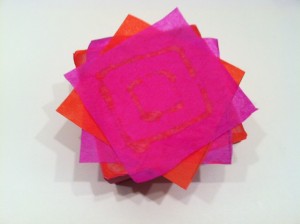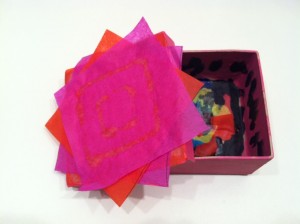Have you ever been asked to design a box to represent yourself?
In one of my classes for art therapy for clinical social work, we were asked to do so. This is the fifth post in the art therapy** series.
The outside of the box was to be decorated (painted, glued, drawn on etc) in such a way that it reflects how you see yourself (or how you think others see you) from the outside.
Conversely, the inside of the box was to be adorned or filled with objects that portray what you don’t show others, the feelings/emotions that you tend to hold/hide inside.
Above is a picture of the outside of my box. As you can see, the top of the box is decorated with a few sheets of fuchsia pink and orange tissue paper glued one on top of the other in an alternating pattern so as to present an upbeat and attractive appearance. This coincides with the general cheerful and “put-together” look I wear on the outside.
Moving onto the inside of my box (as revealed in the image below), I have a mixture of things going on that could be best described as chaos. It includes messy things, disorder, anxiety, painful experiences, sadness and grief as well as anger and frustration.
When the box is closed, the glue that I used to connect the pieces of tissue paper ended up providing a subtle transparency effect. I believe this reflects the partial sharing of my emotions with you, the reader, as well some of my innermost feelings with a few trusted people.
Boxes are particularly useful in art therapy due to their innate capacity to protect and preserve contents, create a safe space within the enclosure to explore and address feelings and/or fears, as well as join opposing parts of self – a frequent therapeutic goal (Farrell-Kirk, 2001; Kaufman, 1996).
Furthermore, the fact that boxes have inherent symbolic value throughout history via caskets, treasure chests and more increase the effectiveness of the box as a therapeutic tool (Farrell-Kirk, 2001; Kaufman, 1996).
Similar to a box, art, in of itself, is a container for feelings, as well as a means of expressing emotion (Kaufman, 1996).
As so eloquently stated by Levine (1992) in (Kaufman, 1996; p. 247), “the task of therapy is not to eliminate suffering but to give voice to it, to find a form in which it can be expressed. Expression itself is transformation… The therapist then would be a therapist of the soul, working with sufferers to enable them to find the proper container for their pain, the form in which it would be embodied.”
What are your thoughts about such an art therapy exercise? Do you feel that it may be a useful one to engage in yourself and/or with one of your clients?
**Caveats:
1) I am a social worker and not an art therapist. The above information is only meant to be seen as a taste of what is involved in art therapy.
2) Please do not substitute material on this site for consultation with an art therapist or mental health professional. It is not intended to serve as mental health advice, let alone assessment, diagnosis, or treatment.
3) Before practicing art therapy, one must obtain sufficient training, supervision and licensing. So You Want to be an Art Therapist, Part Two: Art Therapy Education describes some of the different paths available to those interested in art therapy as a profession or as an additional technique for those who have a master’s degree in licensed mental health professions like counseling and social work.
References:
D. Fagen, LCSW, LCAT, ATR-BC, Creative arts therapy in clinical social work lecture, April 23, 2012.
Farrell-Kirk, R. (2001). Secrets, symbols, synthesis, and safety: The role of boxes in art therapy, American Journal of Art Therapy, (39), 88-92.
Kaufman, A.B. (1996). Art in boxes: An exploration of meanings. The Arts in Psychotherapy, (23), 237-247.




Thanks for sharing this, Dorleem. In my own experience with art therapy I’ve seen how the arts allow folks to explore and share deep unconscious feelings and experiences in a safe way. I think this is also a great tool for social work profession development because we are so immersed therapy at times that its hard not to “be” a social worker, but art therapy helps us in letting go of control. At least for me.
Hope this helps!
Hi Mozart,
Thanks so much for sharing some of your own experiences with art therapy.
It sounds like you have truly reaped some of the benefits of engaging in art therapy. You have not only seen how one may safely discover and explore deep unconscious feelings and experiences but also felt the freedom of the medium itself…
I hadn’t thought about art therapy as a potential self-care tool before but I agree with you – I think that it could serve a wonderful means of release for social workers (and other mental health professionals)!